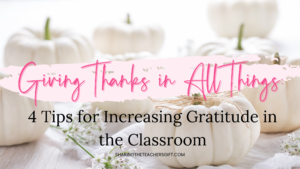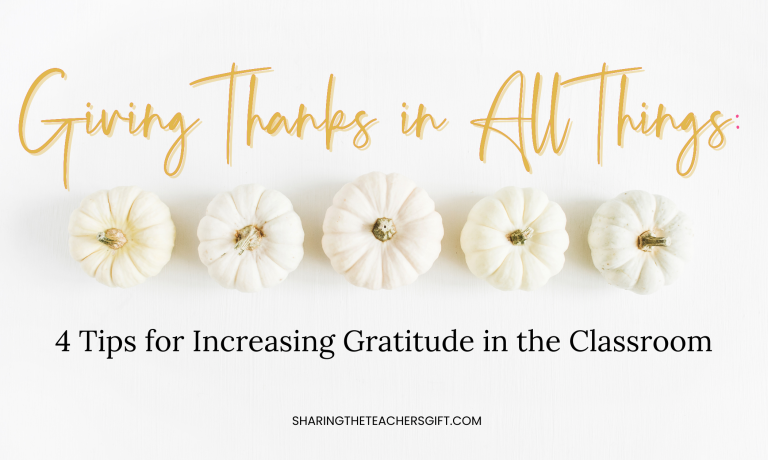First of all, welcome to the Sharing the Teacher’s Gift Blog! In the spirit of giving thanks for all things, I’m grateful you are here and for what I hope will be the beginning of a wonderful journey together! Through Sharing the Teacher’s Gift you’ll find tools, strategies, resources and inspiration for your journey as a teacher that will lighten your teacher load and make your days in the classroom easier. In a time in which teachers’ are working harder than ever before, I hope that you’ll find strength and encouragement here that will inspire you to persevere even on the hardest days. Know that we’re always here to pray for you and cheer you on! So, welcome!
An American Thanksgiving Holiday Revelation
Since this is the first of what I hope will be many blog posts to come, you should know that I’m a Canadian girl, born and raised, living in America. The journey that brought me here is a fruit of prayer, and a story for another time. What’s significant about this personal detail is the fact that I now get to celebrate TWO Thanksgivings: Canadian Thanksgiving in October and American Thanksgiving in November!
While I’ve been celebrating both Thanksgivings for over a decade now, this year is the first year that the placement of the American Thanksgiving holiday in the context of the Church’s Liturgical Year struck me as quite marvelous. Here’s why:
Just last Sunday, the Church celebrated the Feast of Christ the King. This celebration marked the end of the Liturgical Year. It is last Sunday of Ordinary Time before the first Sunday of Advent which will be celebrated this Sunday.
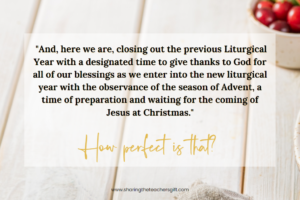
And, here we are, closing out the previous Liturgical Year with a designated time to give thanks to God for all of our blessings as we enter into the new liturgical year with the observance of the season of Advent, a time of preparation and waiting for the coming of Jesus at Christmas.
How perfect is that? A day between the Feast of Christ the King and the beginning of Advent specifically set aside for us to stop and give thanks for all of the blessings in our lives?!?! I cannot think of a better way to simultaneously close out and begin a new year of life in the Church.
Giving Thanks in All Things
This year, every single person in my house ended up sick on Thanksgiving. Unfortunately, this meant declining an invitation to spend time with friends on Wednesday night. It also meant canceling plans with extended family Thanksgiving Day. Needless to say, we were all quite disappointed to have to miss out on these beloved traditions. Yet, even in this disappointment, there was so much for which to be grateful. Here are a few of the blessings that come to mind:
- While we were and still are not feeling 100%, it’s truly just a bad cold.
- We had access to medication to help mitigate our symptoms.
- I had planned ahead and had groceries on hand that we could use to make our own little Thanksgiving Feast in the event that we were all sick, so we were able to celebrate anyway.
- Even if I hadn’t planned ahead, the family we had planned to celebrate with offered to pack us food for pick up.
- We had the means to purchase, make and enjoy a special dinner.
- We were able to celebrate together as a family.
- The weather was beautiful and, even though we weren’t feeling great, we still managed to get outside and throw the football around a little bit.
- We were able to enjoy watching the Macy’s Parade and the Thanksgiving Day Football games together.
- We were able to take some much needed time to rest and recover.
And, in all reality, that’s probably the short list of the things for which we can all be grateful in this household.

Blessings in a Jar
A few years ago, we began a new family tradition. We purchased a Blessings Jar (really, a Mason Jar would do the trick!) and began to write down the things we were grateful for throughout the year. Sometimes the things we wrote down were big, out of the ordinary, special things. Other times, we recorded gratitude for small, precious moments that would be easily forgotten but were significant in the moment.
It used to be that we would open the jar, pour out all of the things we were thankful for, and read them aloud on New Year’s Eve as we considered all that had taken place throughout the year. This year, we moved that celebration to Thanksgiving Day. With regards to our faith and in the context of the Liturgical Year, this shift has been a powerful tool in preparing us to enter into the Advent season peacefully, joyfully and mindful of God’s goodness and generosity.
Benefits of Gratitude
The benefits of gratitude have become an area of interest for researchers. In a Positive Psychology article titled, The Neuroscience of Gratitude and Effects on the Brain, lists several physical, social and, of course, psychological benefits associated with practicing gratitude, including:
- Stronger immune system
- Better sleep-wake cycles
- Fewer aches and pains
- Optimum blood-pressure
- Improved cardiac functioning
- Better communication
- More empathy
- Increased likeability
- Stronger relationships
- More involvement as a team member
- Positive emotions and thoughts
- Increased alertness, awakeness, and self satisfaction
- Enhanced mood
- Better stress regulation
- Reduced anxiety and depression
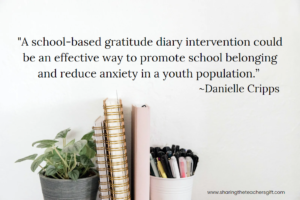
While much of the research citing these benefits has been done with adults, an important study by Danielle Cripps sheds light on the ways that the practice of gratitude can be beneficial for youth, a population in which anxiety disorders have been found to be the most prevalent psychopathology. In her study with elementary school students, the intervention group was asked to record three things they were grateful for each school day over a span of two weeks.
Compared to the control group, students in the intervention group reported decreased anxiety and increased school belonging, leading to the conclusion that implementing a “school-based gratitude diary intervention could be an effective way to promote school belonging and reduce anxiety in a youth population”, demonstrating the benefits of keeping a gratitude journal. In reference to Cripps’ study, a Psychology Today article by Najma Khorrami M.P.H., adds that encouraging gratitude at a young age may be beneficial in lessening anxiety in adolescence.
Practicing Gratitude in the Classroom
This research, the ever increasing emphasis on the necessity of Social Emotional Learning as a consequence of the pandemic, and the repeated emphasis on the importance of giving thanks found in scripture (e.g., Colossians 3:15; 1 Thessalonians 5:16-18; Philippians 4:6; Psalm 7:17; Psalm 107:1…to name a few!), developing ways to incorporate the practice of gratitude into the daily lives of our students is an important task for Catholic and public school teachers, alike. Here are some strategies that have worked well with my students:
- Tip #1: Invite students to keep a gratitude journal, either simply as a gratitude journal (public school) or as part of a prayer journal (Catholic school)
- Tip #2: Encourage students to share one thing they are grateful for as part of our morning meeting each day or class meeting each week/month (depending on the grade level and/or schedule)
- Tip #3: Include a giving thanks prayer as part of your class prayer or invite students to share prayers of thanksgiving as part of our daily or end of week class prayer intention time. For more ideas and resources related to classroom prayer, check out my free resource: A Teacher’s Guide to Classroom Prayer.
- Tip #4: Use a gratitude or blessings jar in the classroom and invite students to write something they are thankful for to add to the jar on a monthly basis. At the end of the year, review their notes of gratitude and celebrate all of the blessings they have received individually and that your class has received as a whole throughout the year!
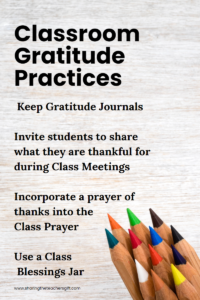
Closing in Thanks
Alright, that’s it for this post. If you’ve made it to the end: Thank you so much for spending your time with me in this space! I hope you will return again soon for more encouragement and inspiration. Praying for you in this season!
Be Well & God Bless,
Courtney
P.S. Looking for resources to help you with teaching the Catholic faith, ELA or easing the behind the scenes of teaching? Check out my TPT Store! Need help with Classroom Management, Parent Communication or Lesson Planning? Check out my course, S.A.I.N.T.L.Y. Classroom ManagementTM on Podia!
References
Cripps, Danielle (2019) Exploring the effectiveness of a school-based gratitude intervention on children’s levels of anxiety, sense of school belonging and sleep quality. University of Southampton, Doctoral Thesis, 142pp.
Khorrami, Najma. “Gratitude Helps Curb Anxiety.” Psychology Today, Sussex Publishers, 20 July 2020, https://www.psychologytoday.com/us/blog/comfort-gratitude/202007/gratitude-helps-curb-anxiety.
Roy Chowdhury, Madhuleena. “The Neuroscience of Gratitude and Effects on the Brain.” PositivePsychology.com, PositivePsychology.com B.V., 9 Sept. 2022, https://positivepsychology.com/neuroscience-of-gratitude/.
Waddell, C., Offord, D. R., Shepherd, C. A., Hua, J. M., & McEwan, K. (2002). Child psychiatric epidemiology and Canadian public policy-making: the state of the science and the art of the possible. The Canadian Journal of Psychiatry, 47(9), 825832. Retrieved from https://journals.sagepub.com/doi/pdf/10.1177/070674370204700903
